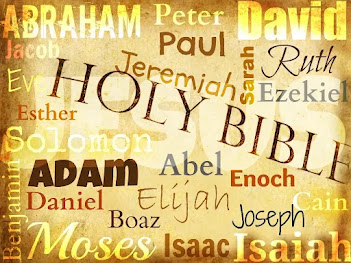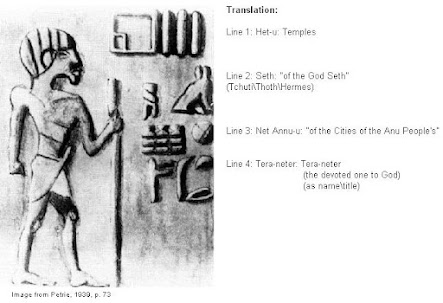Dr. Alice C. Linsley
Names and titles of biblical persons have various etymologies. Some names of individuals refer to places or regions (toponyms) with which the persons are associated. Some examples include Elam (Gen. 10; Ezek. 32:24), Seir (Gen. 36; Is. 21:11; Ezek. 25:8 and 35:10), Uz (Gen. 10, 36:28), and Timna (Gen. 36:12; Josh. 15:10).
Some names are royal titles, some are Horus names, and some identify ancestors, both paternal and maternal. The name Shelah/Salah is a Hebrew name. It first appears in the lists of early Hebrew rulers as the son of King Arpachshad/Har-Pa-Shed, and the father of Eber (Gen. 10:24; Gen. 11:12-14). In ancient Egyptian, Shed (šd) refers to "one who saves" or "the savior." Ar or Har is a Horus name. Judah's son born to his cousin wife was named Shelah (Gen. 38).
As with Jewish names today, most biblical names fall into these categories:
1.
Toponymics
2.
Occupation: One of Abraham's nephews was named Tahash, meaning tanner.
3.
Patronymics
4.
Matronymics
5.
Physical appearance: Adam means "Red Human," formed from red earth.
6.
Economic and/or social status
7.
Plant and animal (totems): The name Shobal (Gen. 36) refers to a young lion.
8.
Allegiance or affiliation
Royal Names
When reading the Bible, it helps to be aware of names and titles. Some of the early Hebrew held royal titles such as
Enoch and Lamech. Enoch refers to the ruler's proper heir, the ascendant son. Lamech is related to the word
melek, meaning king.
La-melech appears on several thousand Egyptian and Hebrew seals (Holman Illustrated Bible Dictionary, p. 95).
Achimelech means “brother of the king." The royal titles Enoch and Lamech are found in the
king lists of Genesis 4 (the line of Cain) and Genesis 5 (the line of Seth).
The affix Ar designates a royal person or a venerable figure. Many rulers of history have such names, including Artaxerxes, Archelaos, Ar-Shem, Artix, Areli, Araxes, Arviragus, a Jebusite named
Araunah, and
Arishen, a Horite Hebrew who ruled a territory in the central Zagros between 2400-2301 BC.
Ariaramnes was the great uncle of Cyrus the Great. The "Ar" may be a shortened Horus name as is suggested by the Nabataean King Harithath IV who bears the Horus name. However, King Harithath is called King Aretas in 2 Corinthians 11:32.
In the ancient world, Horus was regarded as the patron of kings and priests. One of Jesus' uncles, Joseph Ar-Matthea, was a high-ranking ruler-priest. Joseph had sufficient political clout to petition Pilate for the release of Jesus’ body so he could be buried in the sepulcher that Joseph had excavated for himself.
Horus Names
Many early Hebrew rulers had Horus names. Hur is an example. According to Midrash, Hur was Moses’ brother-in-law, the husband of Miriam. Hur’s grandson was one of the builders of the Tabernacle. 1 Chronicles 4:4 lists Hur as the "father of Bethlehem," an early Horite Hebrew settlement.
A chief of the tribe of Asher holds the Horus name Harnepher (1 Chronicles 7:36).
Another Horus name is Na-Hor, the name of Abraham's older brother. Nahor ruled over his father's territory in Paddan Aram when Terah died. In ancient Akkadian, Na is a
modal prefix indicating service to, affirmation, or affiliation. Na-Hor indicates that this man was a devotee of HR, which in ancient Egyptian refers to the
Most-High God.
HR also refers to the Son of God who the Greeks called Horus. His Horus name suggests that
Nahor was a Horite Hebrew. A prayer addressed to Horus says, "For you are he who oversees the gods, there is no god who oversees you!" (Ancient Pyramid Texts, Utterance 573)
A Horite priest (
Sangu sa huru - priest of Horus) is mentioned among five priests in an Assyrian document (SAAB 9 127) from the city of Assur. The document is dated to 639 B.C. The Horite priest is named Qibit-Assur.
Another priest with a Horus name is
Haruninapirru whose name appears on a seal found at Susa in ancient Persia. Har refers to Horus. Unina is a variant spelling of Inanna, Innana or Innin, a goddess resembling Hathor, the mother of Horus. The word
piru or
biru refers to a temple or shrine.
Words for Priests Some names indicate that the person was a priest. Examples include Terah and Korah. Terah/Tera is a very ancient word for priest. This image found by Flinders Petrie shows a
Sethite Hebrew priest. He is a priest (tera) devoted to God (Neter/Netjer).
The word
Korah refers to a priest who shaved his body as an act of ritual purification before his time of service at the temple or shrine. One of Esau's sons was named Korah (Gen. 36:5), as was Moses' brother who challenged his leadership (Num. 16).
Korah's descendants are praised in 1 Chronicles 26, where they are grouped with the gatekeepers of Obed-Edom. Obed-Edom is a connection to Ruth, who named her first-born son Obed. Obed was the father of Jesse, the father of David. This picks up the Messianic thread, pointing us back to the early Hebrew expectation of the Son of God who was coming into the world.
Another word for priest is the Hebrew ‘Kohen’, equivalent to the Arabic Khouri or Kahin and the Persian Kaahen or Kaahenaat which is translated "timeless being". Kahenat means priest in the Ethiopian Church.
Other ancient words for priests include harwa, sem, wabau, kalu (lamentation priest), hekau, and šangû. The Akkadian term šangû is the likely origin of the Latin word saguis and the English word sanguine, both referring to blood. The šangû probably offered animal sacrifice at royal sanctuaries.
According to Umberto Cassuto, the name Lamech is related to the Akkadian word
lumakku, meaning “priest” (
Commentary on Genesis, Vol. 1, p. 233). It also is related to the Hebrew word
melek, meaning “king”. Further, Lamech is related to the Akkadian words
maklu (burnt offering) and
malku (ruler-priest). The Lamech of Genesis 4 was a Hebrew ruler-priest.
Patronymics
A patronymic is a personal name based on the given name of one's father or a famous male ancestor. These names are identified by the word bar, meaning son or male descendant. In Numbers 13, Caleb is designated Kalev ben Jephunneh. 1 Chronicles 2:19 refers to Hur ben Kalev. Patronymics are common in the Hebrew Bible.
In some cases, high ranking women are also identified with a famous male ancestor. One example is Bath-Sheba, Solomon's mother. She was of the royal house of Sheba. This is why one of the entrance pillars of the Temple commemorates Jachin, a name associated with the clan of Sheba.
Patronymics are also found in the New Testament. An example is the name Bartholomew, the Aramaic patronymic Bar-Talmai.
Matronymics
A matronymic is a personal name based on the given name of one's mother, grandmother, or any female ancestor. Matronymics are not as common among the Hebrew as patronymics, but they do appear in the cases of Hebrew women of social influence, prestige, and wealth. An example is found with the Virgin Mary's full name: "Miriam Daughter of Joachim, Son of Pntjr". Some editions of the Talmud name Jesus as the son of a Roman soldier named Pantera, discrediting his miraculous conception as the Son of God. However, Pntjr refers to Joachim's mother, the maternal great grandmother of Jesus Messiah.
From pre-dynastic times among the Nilotic Hebrew,
ntjr designated God or the divine. The name Pntjr is Pa-Netjer, the name of Joachim’s mother. She must have been of high social status for a matronymic to be employed. That Panetjer is a matronymic is evident from a
limestone stela (1539-1291 B.C.) at the Brooklyn Museum bearing the names of Pekhty-nisu and his wife Panetjer. It is certain that Mary’s ancestors were high ranking ruler-priests because even those who hated her admit this in Sanhedrin 106a which claims: “She who was the descendant of princes and governors played the harlot with carpenters.”



No comments:
Post a Comment
Your comments are welcome. Please stay on topic and provide examples to support your point.